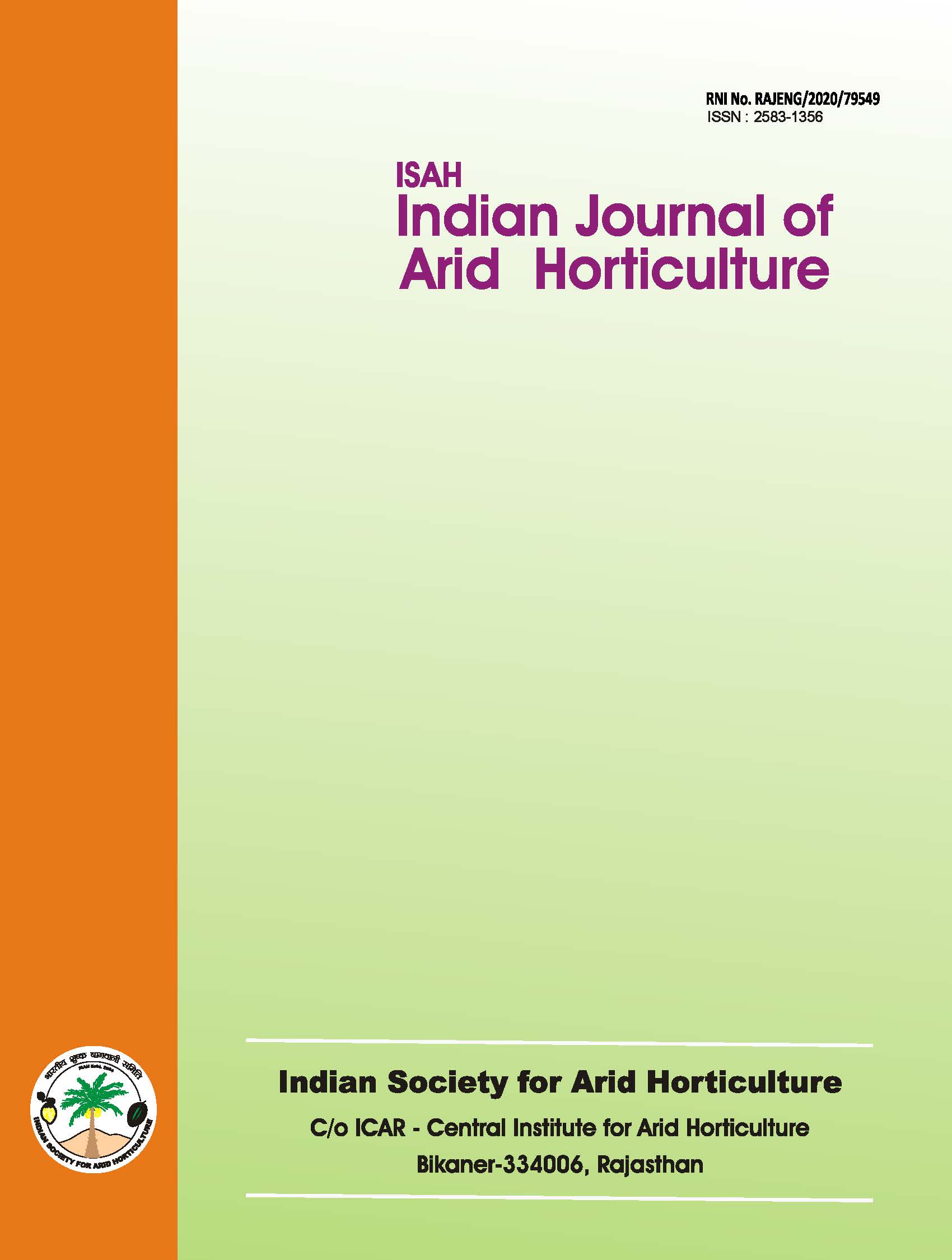Effect of gamma irradiation on seed germination and survival of seedlings of pomegranate (Punica granatum L.)
Keywords:
pomegranate, Andhra PradeshAbstract
Pomegranate (Punica granatum L.) is the important crop of arid and semi-arid regions of India. Maharashtra is the leading state for area and production of pomegranate followed by Karnataka and Andhra Pradesh. At present, Maharashtra occupies about 92,000 ha area out of 1.3 lakh ha area available under pomegranate in India. In pomegranate, genetic base is very narrow. Therefore, creation of variability is utmost important need for crop improvement programme. Attempts have been made earlier to induce mutation in pomegranate by treating seeds with gamma rays (5-20 kR) and various forms were obtained with desirable traits. However, the dwarf mutation forms were most commonly observed in pomegranate (Akhund- zade-IM. 1979 and Levin, 1990). Gamma irradiation as a breeding tool to create variability in both horticulture and field crops was reported by several workers (Haskins and Chapman, 1956; Mikaelsen, 1968 and Pathak, 2003). Several released varieties of field and fruit crops have been enlisted which were developed through gamma irradiation (Anon., 1981). Considering the significance of gamma irradiation in crop improvement, the present study was under taken and response of gamma irradiation on seed germination and subsequent survival of seedlings of pomegranate was studied.Downloads
References
Akhund-Zade, I.M. (1979). Study of the effect of radiation on subtropical fruit crops. Subtropicheskie Kultury, 3, 13-14.
Evans, H.J. (1965). Effects of radiation in meristematic cells. Radiation Botany, 5, 171-182.
Gordon, S.A. and Weber, R.P. (1955). Studies on the mechanism of phytohormone damage by ionizing radiations. I. The radiosensitivity of indole acetic acid. Plant Physiology, 30, 200-210.
Haskins, F.A. and Chapman, H.W. (1956). Effect of irradiation, maleic hydrazide, temperature, and age on enzyme activity in seedlings of corn (Zea mays L.). Physiologia Plantarum, 9, 355-362.
Levin, G.M. (1990). Induced mutagenesis in pomegranate. Dostizheniya Nauki v Praktiku Kratkiet Ezisy Dokladov k Predstoyashchei Nauchnoi Konferencetsii Puti Uskoreniya Selektsionnogo Protsessa Rastenii, pp. 126-128.
Mackey, J. (1951). Neutron and X-ray experiments in barley. Hereditas, 37, 421-464.
Mikaelsen, K. (1968). Effects of fast neutrons on seedling growth and metabolism in barley. In: Neutron Irradiation of Seeds. II. Technical Report Series No. 92. IAEA, Vienna, pp. 63-70.
Moe, C.C. and Han, J.J. (1973). Methods of inducing mutations in cassava and possible uses of the mutant. In: Induced Mutation in Vegetative Propagated Plants, IAEA, Vienna, pp. 67-75.
Pathak, R.K. (2003). Genetic improvement in aonla. In: Status Report on Genetic Resources on Indian Gooseberry - Aonla (Emblica officinalis Gaertn.) in South and South-East Asia, IPGRI, New Delhi, pp. 30-31.
Quastler, H. and Baer, M. (1950). Inhibition of plant growth by radiation III. Successive radiation effects and homologous responses. Biological Abstracts, 24, 39-84.
Skoog, G. (1935). The effect of X-irradiation on auxin and plant growth. Journal of Cell Components and Physiology, 7, 227-270.
Vishwanathan, T.V., Sunil, K.P., Mahato, K.C., and Jaya, M. (1992). Effect of gamma irradiation on the M₁ generation of Kaempferia (Kaempferia galanga).

